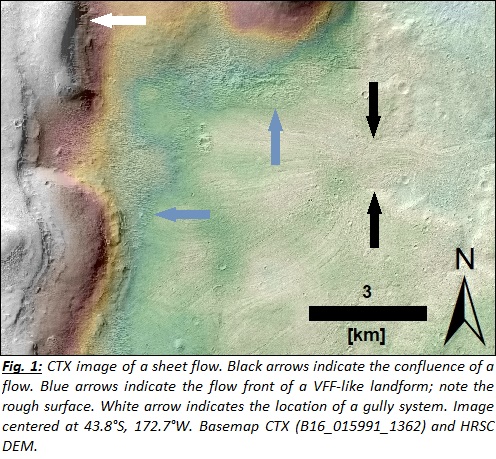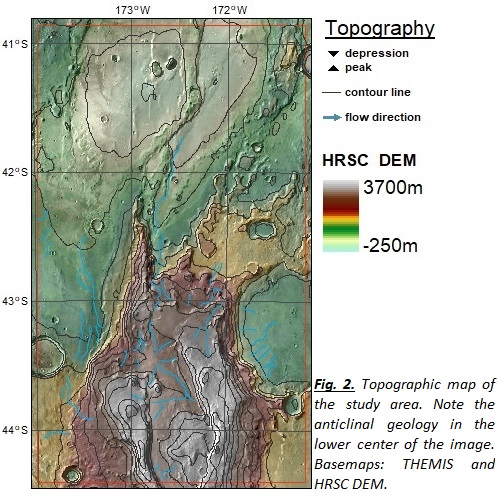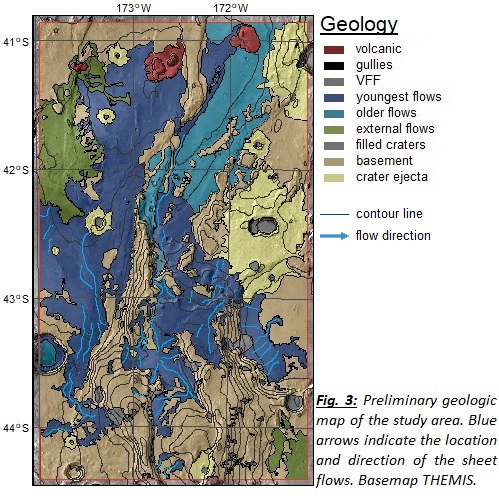The Melting Mountains of Mars? - Mud Flows in a Montane Environment, Terra Sirenum
- European Space Agency, European Space Astronomy Center, Camino Bajo del Castillo s/n, Villanueva de la Cañada, E-28692 Madrid, Spain (martin.voelker@esa.int)
Introduction
During an extensive grid-mapping campaign in the southern highlands of Mars [1], we detected sheet flow deposits on top of a mountain range in Terra Sirenum (located at 44°S, 188°E; Fig. 1,2). Although such formations have been described before near outflow channels and fissures [2,3], they were never observed on top of mountains. The related mountain rises up to 3,000 m above the surrounding plains, and appears to be formed by tectonic activities [4,5] during the Noachian [4]. It is also characterized by the highest internal heat flux values on Mars [6] and strong remnant magnetic fields [7,8]. Its general topography has similarities with a geological anticline, whose crest has been eroded, revealing an older outcrop (Fig. 2).
The high plains of the mountain consist of multiple flat valleys, whose floors are covered by an even deposit with distinct flow margins. Their surface is often characterised by lineations following the direction of the flow. They usually commence near the base of steep scarp crests. Their lengths may exceed 100 km, and their origin often coincides with viscous-flow features (VFF) [9] and gullies [10,11,12].
Methods & Results
For analysing the sheet flow deposits we mapped their distribution (Fig. 3) based on CTX imagery [12], measured their thickness using MOLA single shot profiles [13], and determined their age by crater counts [14,15]. Based on these results we were able to reconstruct the stratigraphy of these flows and their relation to VFF and gullies.
Most sheet flows start at the base of steep scarp crests, following the topographic gradient down to the adjacent basins surrounding the mountain. Near these scarp crests, the flows are often covered by other deposits, resembling to VFF/glacier-like flows [9]. VFF are assumed to consist of water ice and solid particles [9]. In the study area, VFF are located in wide alcoves, steepening the adjacent crest. Their upper reaches are partially eroded or covered by gully deposits, which are assumed to be formed by water even today [11,12].
On their way down the sheet flows converge into small channels (Fig. 1) and diverge into small basins afterwards, indicating a certain viscosity of the flow material. All flows originating from the mountain emanate into two separate basins to the north where they terminate. Each of these basins contains a small volcanic edifice surrounded by lava layers [16].
The thickness values of the sheet flows vary from 5.6 to 31.7 m (based on 9 measurements), while the VFF range from 39.6 to 89.1 m (7 measurements). We also measured the thickness of volcanic flows found in the basins, having a depth of 85.3 to 103.8 m (3 measurements).
The mountain itself is lacking clear volcanic morphologies, and the relation of the flows to VFF and gullies, suggests that the sheet flows are not of volcanic origin. This assumption is supported by the age determination; while the volcanic flows are the oldest flows in the entire study area (~1.2 Ga), the sheet flows (~100 – 190 Ma) and VFF (~37 Ma) are much younger.
Discussion
Synthesizing the results, we suggest the following scenario: The mountain formed during the Noachian by tectonic processes. The small volcanoes in the basins north of it formed during the mid-Amazonian. During the latest Amazonian the sheet flows began to form (as slowly moving mud flows of high viscosity). However, we cannot yet determine the origin of the volatiles bound within the flows; they either originate from volatile-rich subsurface deposits or from atmospheric deposition in form the latitude-dependent mantle LDM, consisting of ice and dust [17]. In both cases, we suggest that the high internal heat flux [6] has triggered the melting and mobilisation of the volatiles. A preliminary screening on other mountain ranges with much lower heat flux values did not reveal further findings of such deposits. Hence, the internal heat flux can be considered a realistic scenario unleashing the volatiles.
After the sheet flows formed, they were covered by the stratigraphically more recent VFF. However, VFF show a rough morphology in contrast to the smooth sheet flows, and they are also much shorter (up to a few kilometres in length). This morphologic difference could be explained by a lower availability of volatiles, after much of the volatiles were already removed when the older sheet flows formed. The different volatile/solids-ratio of the VFF may have resulted in an even higher viscosity, and hence, different morphology. In this scenario, the volatiles have a subsurface origin rather than an atmospherical.
We also cannot exclude that the volatiles that formed both landforms (sheet flows and VFF) have each a different origin; it might be that the sheet flows originate from subsurface volatiles while the VFF originate from mobilised atmospheric volatiles (LDM).
However, it remains unknown why the sheet flows commenced during the late Amazonian and not before. But if the scenario of a warm subsurface and the presence of water is correct, the mountain could be an important location for the search of astrobiological signatures.



References
[1] Voelker et al. (2020), Icarus 346, 113806. [2] Burr and Parker (2006), GRL 33, L22201. [3] Voelker et al. (2018), Icarus 307, 1–16. [4] Tanaka et al. (2014), Geol. Map of Mars, US Geol. Survey Sci. Inv. Map 3292. [5] Karasözen et al. (2016), JGR Planets 121, 916–943. [6] Hahn et al. (2011), GRL 38 (L14203). [7] Connerney et al. (2005), Proc. Natl. Acad. Sci. USA 102 (42), 14,970-14,975. [8] Langlais et al. (2019), JGR Planets 124, 1542–1569. [9] Milliken et al. (2003), JGR 108 (E6), 5057. [10] Levy et al. (2009), Icarus 201, 113–126. [11] Dundas et al. (2010), GRL 37 (7), L07202. [12] Harrison et al. (2015), Icarus 252, 236–254. [13] Malin et al. (2007), JGR 112, E05S04; [14] Smith et al. (2001), JGR 106 (E10), 23,689–23,722. [15] Kneissl et al. (2011), Icarus 250, 384-394. [16] Michael et al. (2012), Icarus 218, 169–177. [16] Brož et al. (2015), EPSL 415, 200-212. [17] Kreslavsky and Head (2002), GRL 29 (15), 14-1–14-4.
How to cite: Voelker, M., Cardesín-Moinelo, A., and Martin, P.: The Melting Mountains of Mars? - Mud Flows in a Montane Environment, Terra Sirenum, Europlanet Science Congress 2020, online, 21 September–9 Oct 2020, EPSC2020-192, https://doi.org/10.5194/epsc2020-192, 2020

